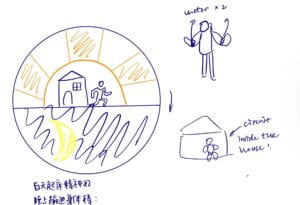Day, Night, Dance! – Amelia Shao – Margaret Minsky

In previous classes, we saw a lot of interactive projects, and then I defined interaction is that users can do something to change the statement of the project and receive a message of the change. I don’t think the little house was made before, but we were inspired by a Chinese comedy show. Honestly, the core idea was to use what we learned from the class and make something interesting, but meanwhile, we also wanted to convey the idea that we can control our mood and enjoy our life.
CONCEPTION AND DESIGN:


After we took the lecture about the The design of everyday things, we thought about the “perceived affordance” and “timely & relevent feedback”. We must let the audience know what they can do to interact with our project. There are two changes that can be made by audience. Firstly, we thought that everyone would definitely lift the roof if there is a handle on it, and they would press the button if they saw one there. (However, the user test let us know it’s not clear enough.)
For the material, we chose cardboard because it’s cheap, easy to find, and easy to build up. We didn’t use other materials as time was not enough to discover other possibilities, but I guess cardboard was good enough.
FABRICATION AND PRODUCTION:
Amber and I worked together this time. She firstly proposed the idea, and we discussed together to complete our plan. During the making process, basically she focused on programming, I was in charge of the circuit and decoration, and we cooperated to do cardboard things. Almost every time we worked together in 826 when both of us were free, communicating face-to-face and addressing problems with joint effort. One of the biggest problems was the misuse of the light sensor. The light sensor in our kit didn’t work as we thought, so after several failed test, we turned to professor Minsky for help. She mentioned that the LDR may fit our needs better, and after testing 3 or 4 LDR desperately, we finally find a good one. (Sad story: it’s so hard to find perfectly working equipment from the public tool cart.) Another problem is the unstable connection between cables. We connected too many cables to support the LED and button, and thanks to professor Minsky’s instruction, at last, we finally know that we could bend several self-cut cables together to solve the problem. Both of us were really mad sometimes because of all the errors or unpredicted problems, but I really appreciated Amber’s constant effort to perfect our codes and finally make it.

The user test session was really important to us. We had already spent a lot of time designing and test our interaction part before. However, when it was applied to use, many problems occurred. We made notes and planned out a list, used the following several days to remake our little house and do reprogramming.




As I mentioned before, we changed our way of writing some instructions: OPEN THE DOOR or PRESS (the button) OR NOT, and apparently, it’s much clearer. Instead of lifting the roof, you can open the door to wake the little man up (with a written instruction); Instead of pressing the button next to the door, you can press it more steadily; instead of changing the background, you can see a clock-like sign to show whether it’s daytime or nighttime.

(Halloween surprise!)


CONCLUSIONS:
Our idea was to visualize emotions of people in different periods during a day. And the dance part conveys the idea that we can cheer ourselves up by dancing, whether day or night. It aligns with my definition of interaction that users can do something to change the statement of the project and receive a message of the change. The audience acted as we expected: open the door, press the button, and close the door. Sadly, our instruction is still not clear enough because some of them didn’t get the idea that they can open the door. According to the audience’s response, they thought the project is cute and interesting to play with, but I don’t think they got our idea of the emotional change. At first, we hope our project could be not only interesting but also meaningful by suggesting staying positive like the little man, but our final presentation slightly blurred the “sadness” part because they thought the little man was sleeping rather than feeling sad. I hope we could realize more movements such as moving the neck and legs and find out a better way to convey our idea clearly if we have more time.
Professor Minsky’s words left me with a deep impression: “You don’t have to struggle all by yourself. Find someone to help you.” Mostly we tried to solve the problem by searching for information online or doing experiments, which was necessary during the whole process. But we also tried to get help from learning assistants, professors, and other colleagues, without them we could never make it. A failure can be a lesson that I may never forget, for example, I will always remember that bending cables together is a wonderful way to make the connection tight.
(As Amber was in charge of the code, I will not copy & paste our looong code here.
But here is the reference I used for circuits:
organizing:https://www.arduino.cc/reference/en/
http://yhhuang1966.blogspot.com/2015/10/arduino.html